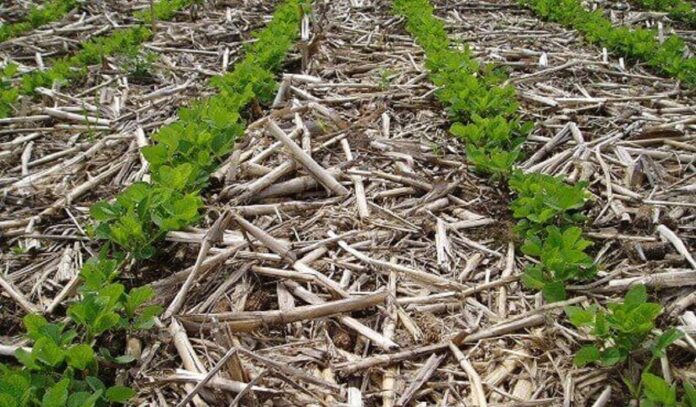The way farmers prepare the soil for agricultural activity has a great impact on sustainable food production. Farmers use varying methods of preparing their lands for cropping.
Usually, farmers prepare their lands by slashing and burning of vegetation residue and many farmers have adopted this technology for years. Some farmers may turn the soil (plough) afterwards. However, these farmers are gradually realising the dangers the technology poses to the productivity of soils in the long-term production of food.

What is no-till farming?
No–till farming (also called zero tillage) is a way of growing crops or pasture from year to year without disturbing the soil through tillage. (Wikipedia)
Read also: Change to Conservation Agriculture : Increase yields and improve farmlands
What is Conventional tillage?
In conventional tillage, farmer turns over the soil to loosen it and make it workable or with the intention to enhance the growth of the crops. However, this exposes the soil to erosion by wind or rain, washing away the topsoil needed for the crops to grow.
Local farmers usually carry out tillage by slashing and burning the vegetation before sometimes, ploughing.
Read also: 7 Negative effects of soil tillage
No-till farming Vs Conventional agriculture
Now, in this comparison, let’s consider why we encourage No-till farming under conservation agriculture over the Conventional tillage (Slash and burn and Plough).
| NO-TILL FARMING | CONVENTIONAL AGRICULTURE | |
| 1 | Maintains soils structure | Destroys soil structure |
| 2 | Crop residue covers the surface of the soil | Soil surface left bare |
| 3 | Increase organic matter | Reduces organic matter |
| 4 | Enhanced soil organism activity | Beneficial soil organisms are destroyed |
| 5 | The soil is protected against erosion. | Soils are exposed to erosion. |
| 6 | Conserves soil moisture for plants’ use | Soil loses moisture rapidly |
| 7 | Maintains soils texture. | Creates hardpan beneath the topsoil with time |
| 8
| Farmers can use farmlands for longer periods of time with maintained fertility and structure. | Farmlands, over time, loses its quality to support plants growth. |
| 9 | No ploughing reduces the cost of production | Ploughing is a huge cost to production |
| 10 | Vegetative residue controls weeds | Bare land encourages weeds growth |
| 11 | Reduced or no chemicals required for weed control | Weed control is a major challenge, therefore, more chemicals are used. |
| 12 | Effective against climate change. | Total crop failure in a prolonged dry period. |
| 13 | It is highly sustainable. | Not sustainable. |
| 14 | Vegetation residue decomposes to fertilize the soil. | No vegetative residue. |
| 15 | Less use of fertilizers or not necessary. | Must use Increased quantities of fertilizer. |
| 16 | Conserves nature. | Destroys nature. |
| 17 | Reduces carbon emissions through greater sequestration of carbon dioxide by the soil. | Increases carbon emissions. |
| 18 | The release of nitrous oxide (a dangerous greenhouse gas) is reduced. | Increases the release of nitrous oxide. |
| 19 | Controls runoff of contaminated water from used agrochemicals into other water bodies due to increase water infiltration and retention. | Encourages runoff of water. |


